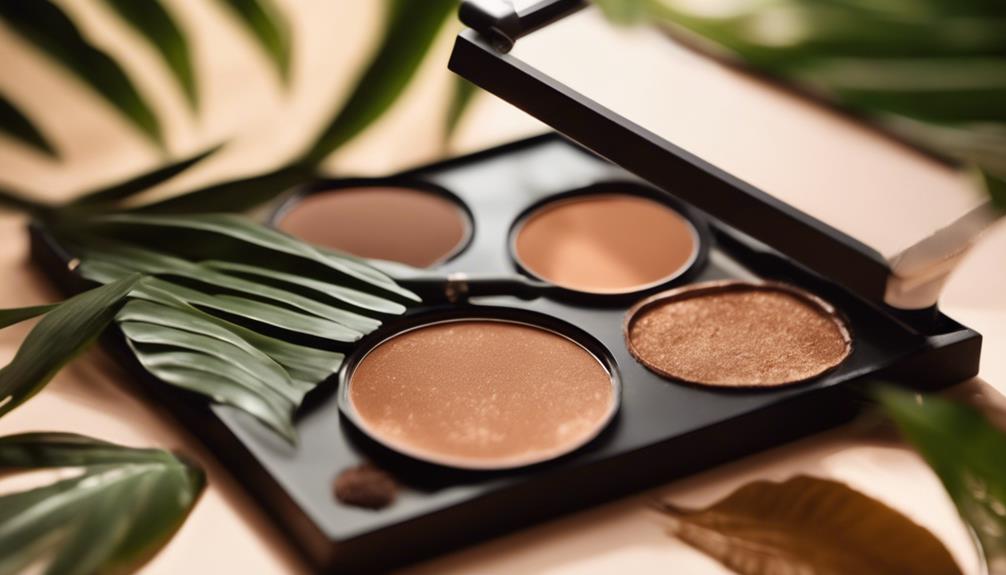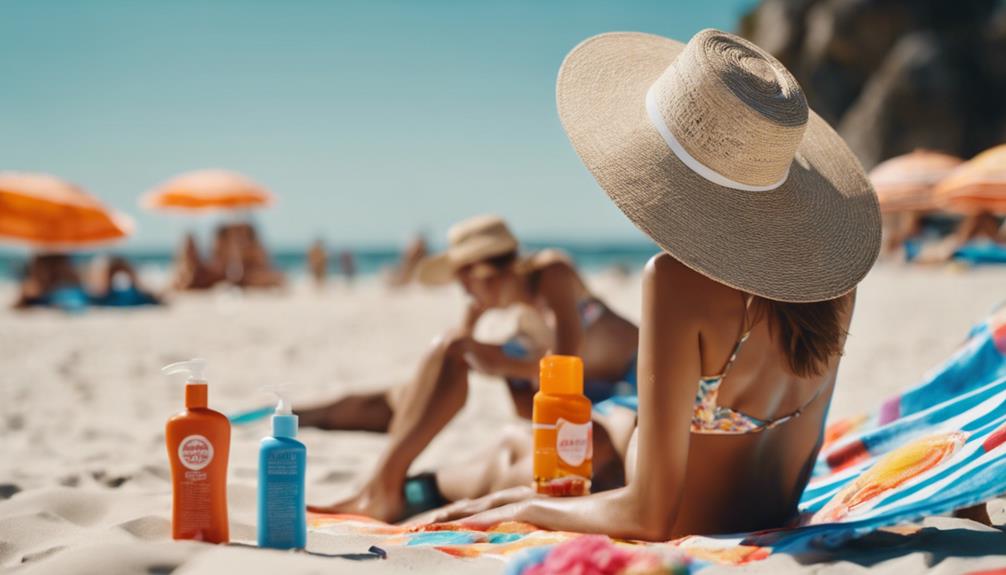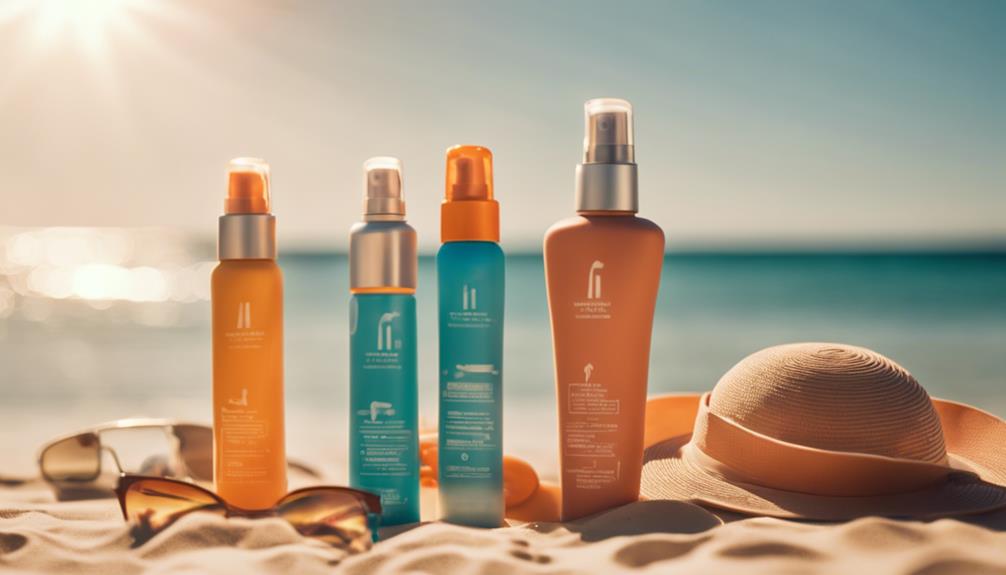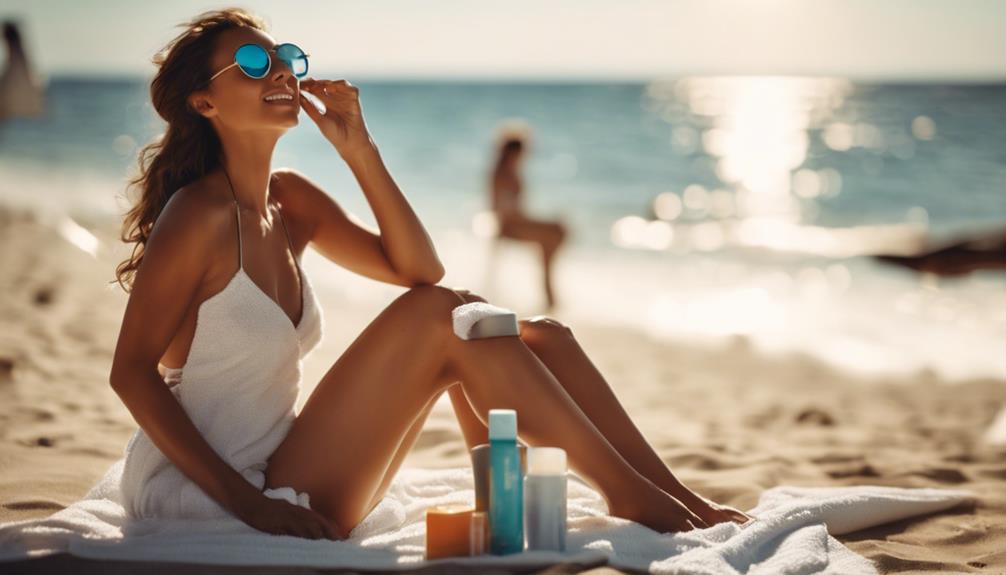To master the art of safe tanning, you need to start slow. Begin with 5-10 minutes of sun exposure and gradually increase your time, always monitoring your skin for any pinkness. Use a broad-spectrum sunscreen with at least SPF 30, reapplying every two hours. For best results, tan during off-peak hours, before 10 AM or after 4 PM. If you're using bronzers, choose shades with cooler undertones and exfoliate beforehand. Stay hydrated to keep your skin healthy while you tan. There's so much more to uncover about achieving that perfect glow safely.
Key Takeaways
- Start with short sun exposure sessions of 5-10 minutes, gradually increasing time while monitoring skin reactions for safety.
- Always apply a broad-spectrum SPF 30 or higher sunscreen generously before tanning and reapply every two hours.
- Choose optimal tanning times before 10 AM or after 4 PM to reduce UV intensity and minimize skin damage.
- Use protective clothing, wide-brimmed hats, and sunglasses to enhance sun safety while tanning outdoors.
Sun Exposure Guidelines
When you're aiming for a safe tan, it's crucial to start with short sun exposure sessions, especially if you have fair skin.
Begin with just 5-10 minutes in the sun, gradually increasing by 5 minutes each time.
Keep an eye on how your skin reacts: no redness means you can extend your time, while slight pinkness indicates it's best to retreat.
Avoid long sessions to prevent painful burns and skin damage.
The safest tanning times are before 10 AM or after 4 PM, when the sun's rays are less intense.
Importance of Skin Protection
Protecting your skin with a high SPF sunscreen is essential to prevent burning and long-term damage while tanning.
Always choose a sunscreen with at least SPF 30 and apply it generously before heading out into the sun. Don't forget to reapply every two hours, especially after swimming or sweating.
Remember, your fair skin is more susceptible to UV damage, so take extra care. Consider wearing protective clothing, a wide-brimmed hat, or sunglasses to shield yourself further.
After tanning, hydrate your skin with a good moisturizer to combat dryness and irritation. This simple practice not only helps maintain your tan but also promotes overall skin health.
Prioritize skin protection, and you'll enjoy a safer tanning experience.
Selecting the Right Bronzer

Choosing the right bronzer can enhance your natural glow and complement your fair skin tone beautifully. Start by testing bronzer shades on your jawline; look for options one or two tones darker than your skin.
Opt for bronzers with cooler undertones, like honey or soft golden shades, to avoid that unwanted orange tint. Before applying, exfoliate your skin for a smoother finish, ensuring an even application.
If you prefer a chic look, consider a matte bronzer; if you want a touch of radiance, go for one with subtle shimmer. Remember, less is more—build up the color gradually for a natural appearance.
With the right bronzer, you'll achieve a sun-kissed look without the sun damage.
Challenges of Fair Skin
Tanning with fair skin presents unique challenges, as lower melanin levels increase the risk of burning instead of achieving a desirable tan. You need to be cautious and patient when exposing your skin to the sun.
Gradual tanning is essential; start with short sessions of just 5-10 minutes and slowly extend your time. Always monitor your skin's reaction, and remember that even a slight pinkness indicates it's time to retreat.
Using a high SPF sunscreen is a must to protect against harmful UV rays. Avoid the temptation to rush the process; it can lead to painful burns and long-term damage.
Effective Tanning Techniques

Understanding your skin's needs is essential for adopting effective tanning techniques that maximize results while minimizing the risk of burns.
Here are some key strategies to enhance your tanning experience:
- Start slow: Gradually increase sun exposure, beginning with short sessions of 5-10 minutes.
- Use sunscreen: Always apply a broad-spectrum SPF 30 or higher to protect your skin.
- Choose the right time: Opt for tanning before 10 AM or after 4 PM to avoid peak UV intensity.
Tanning Bed Best Practices
When using tanning beds, it is crucial to prepare your skin properly to maximize results and minimize risks. Start by exfoliating to remove dead skin cells, ensuring an even tan. Always wear protective eyewear to shield your eyes from UV rays. Limit your sessions to avoid overexposure; twice a week is a good rule of thumb. Hydrate your skin before and after tanning to prevent dryness.
Here's a quick guide on tanning bed best practices:
| Practice | Description |
|---|---|
| Exfoliate | Remove dead skin for an even tan |
| Wear Protective Goggles | Shield eyes from harmful UV rays |
| Limit Sessions | Aim for no more than twice a week |
| Moisturize | Keep skin hydrated before and after |
| Monitor Skin Reaction | Adjust duration based on skin response |
Innovations in Tanning Products

Recent advancements in tanning products are transforming how you achieve and maintain a healthy glow while prioritizing skin health. Today's innovations focus on enhancing your tanning experience without compromising your skin.
Here are some exciting developments to explore:
- Natural Ingredients: Many products now feature organic extracts and natural oils, ensuring safer tanning options.
- Hydrating Formulas: Moisturizing ingredients help prevent dryness, keeping your skin supple during and after tanning.
- Customizable Tans: New formulations allow you to adjust the depth of your tan, giving you more control over your desired shade.
With these innovations, you can enjoy a beautiful tan while caring for your skin.
Frequently Asked Questions
How Often Should I Reapply Sunscreen While Tanning?
You should reapply sunscreen every two hours while tanning, or immediately after swimming or sweating. Make sure to apply a generous amount before heading out, ensuring you stay protected from harmful UV rays.
Can I Tan Using a Self-Tanner Instead of the Sun?
You can absolutely achieve a sun-kissed glow with self-tanner—it's like magic in a bottle! Just choose a shade that complements your skin tone, apply evenly, and enjoy a tan without the sun's harmful rays.
What Are the Signs of a Tanning Overdose?
If you're experiencing excessive redness, peeling skin, or blistering, you've likely overdosed on tanning. Other signs include extreme sensitivity and discomfort. Always listen to your skin, and take breaks to avoid these reactions.
Is Tanning Safe for All Skin Types?
Tanning isn't safe for all skin types. If you have fair skin, you're at a higher risk of burns and damage. Always consider your skin's unique needs and prioritize safety when tanning.
How Can I Prevent Peeling After Tanning?
To prevent peeling after tanning, keep your skin moisturized daily. Use a gentle, hydrating lotion and drink plenty of water. Avoid hot showers and exfoliation for a few days to maintain your tan.
Conclusion
In mastering safe tanning, you're not just chasing a golden glow; you're prioritizing your skin's health.
By following sun exposure guidelines and using effective protective measures, you can achieve the tan you desire without risking damage.
Remember, fair skin requires extra care, so embrace gradual techniques and high-quality products.
With the right knowledge and practices, you'll enjoy a radiant complexion that lasts.
So go ahead, soak up the sun wisely, and let your skin shine beautifully!









